|
|
|
|
|
|
|
Achi-Kochi Japan
Showing many places to visit and foods to eat in Japan
|
|
|
|
|
|
|
|
|
|
|
|
|
Japan
> Kanto region
> Kamakura
|
|
|
|
|
|
|
Kamakura City
Kanagawa Pref., Kanto ( Achi-Kochi Japan )
|
|
|
|
|
|
|
|
|
|
|
|
|
( "Achi-Kochi" in Japanese means "Here and there" in English. )
Kamakura City, Kanagawa Pref., Kanto
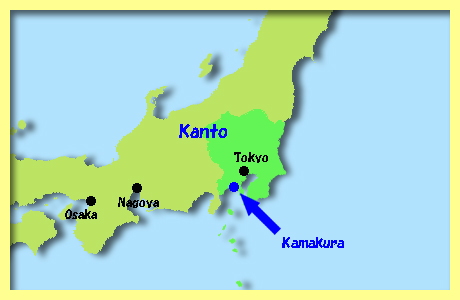
Kamakura is a city, Kanagawa Prefecture, located in the south of Kanto region. Kamakura Shogunate was establised in Kamakura at the end of the 12th century. Since then on, the city had been the political capital of Japan for two centuries, while Kyoto remained the capital city officially.
|
|
Yoritomo Minamoto

Yoritomo Minamoto establised Kamakura Shogunate in the city in A.D.1185. His statue ( above ) stands in Kamakura. Though his family, descendants of the Emperor Seiwa, had been the head of influential group of samurai warriors, his father was defeated by the Taira family in a war in A.D.1160 and executed. So Yoritomo in his early teens was exiled.
In A.D.1180 another war broke out. Yoritomo Minamoto led samurai warriors, who had been commanded by his ancesters, and joined the war against the Taira family, a rival of his family and the most influential at the time. Finally Yoritomo destroyed his enemy and established in Kamakura his own shogunate, the first samurai government in Japan.
( ==> A History of Japan vol.2 Samurai Age )
|
|
Tsurugaoka Hachimangu

Tsurugaoka Hachimangu, a shrine located in Kamakura, is popular among tourists as above. The shrine was founded in Kamakura in A.D.1063 by Yoriyoshi Minamoto, one of the ancestors of Yoritomo and Yoritomo moved the shrine to its present site.
Kamakura is a place which Yoritomo's ancestors were deeply related to and the city, surrounded by the mountains and the sea, is a place easy to defend. In addition, in its surrounding areas, there lived many samurai warriors who had belonged to the group headed by the Minamoto family. In such a city, Yoritomo establised his shogunate.
|
|
Kotoku-in and Daibutsu
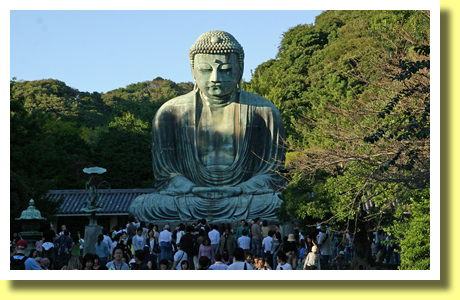
Lots of people visit Kotoku-in Temple in Kamakura to see Daibutsu ( huge bronze statue of Buddha - above). It is said that the statue was completed in the 13th century. Kamakura Daibutsu is one of designated National Treasures of Japan.
The statue had been placed in the huge Buddha hall, which was destroyed by storms and rebuilt twice in the 14th century. However the hall was destroyed in A.D.1498 by the earthquake and tsunami. Since then on the Daibutsu has been standing without the hall.
|
|
Zeniarai-Benzaiten
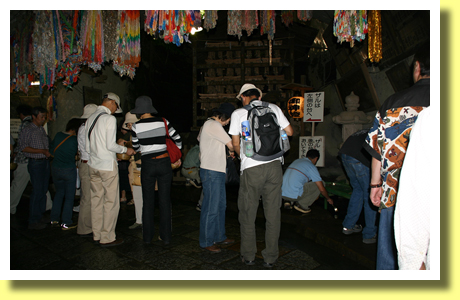
Zeniarai-Benzaiten Shrine is also popular, perhaps not because the shrine was founded in A.D.1185 by the 1st shogun, Yoritomo Minamoto. Lots of people visit the shrine and they go into the cave ( above ) in the inmost of the shrine. There is the secret in the cave.
|
|
Wash Money

Out of a spring, one of the five famous springs in Kamakuera, in the cave gushes clear water, with which people wash their money ( above ). They believe that money, washed in the cave, be multiplied.
This shrine is called "Zeniarai-Benzaiten". "Zeniarai" in Japanese means "washing money", while "Benzaiten" is "a goddess confering monetary fortune. So people visit this shrine.
|
|
Sugimoto-dera Temple
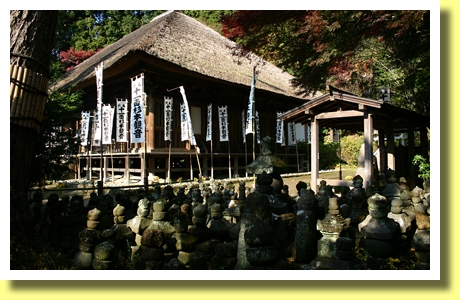
Sugimoto-dera Temple was founded in the 8th century and the oldest temple in Kamakura, though the main hall ( above ) was built in A.D.1678. In front of the main hall, there are hundreds of stone stupas ( above ) built for samurai soldiers who lost their lives in the battle in the temple's premises in A.D.1337.
After Kamaukura Shogunate was destroyed in A.D.1333, there were some battles between samurai soldiers supporting Kamakura Shogunate and the enemies, one of which was the above mentioned.
The main hall enshrines three statues of Kannon. When a fire broke out in A.D.1189, the statues were rescued and laid under a ceder tree. Since then on the temple was called "Sugimoto-dera", they say. "Sugimoto" in Japanese means "Under a ceder tree", while "dera" does "temple".
|
|
Meigetsu-in Yemple
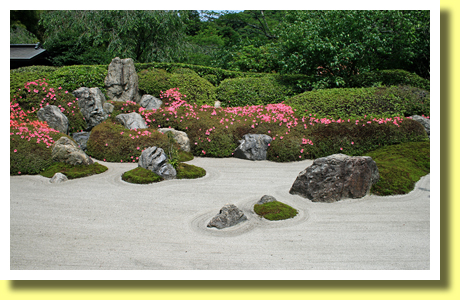
Meigetsu-in is a temple founded in the 13th century in Kamakura. The temple is famous for hydrangea flowers. Also in the temple, there is a Karesansui garden ( above ).
The Karesansui garden represents Shumi mountain, which is sacred mountain, the center of the world according to Buddhist cosmology. Karesansui is a Japanese style rock garden, in which raked sand represents ripples in sea/river.
|
|
Hase-dera Temple
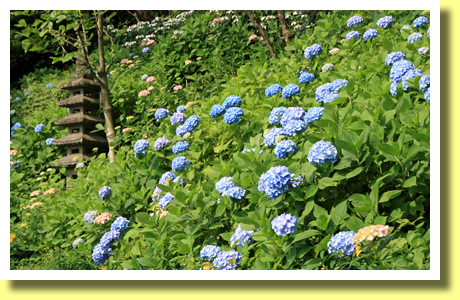
So many people visit Hase-dera Temple in Kamakura, especially in the rainy season ( mid June - late July averagely ) to see hydrangea flowers ( above ). The temple is very famous for hydrangeas as well as the wooden statue of 11-faced Kannon ( taller than 9 meters ).
|
|
Enoden trains
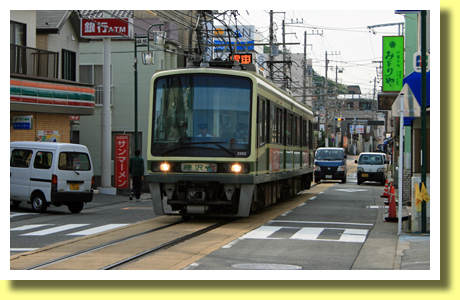
Enoden trains ( above ) would help tourists visit places Achi-Kochi ( here and there ) in Kamakura. "Enoden" is short for Enoshima Dentetsu ( Enoshima Electric Railway ) and they call the railway "Enoden". Its total railway length is about 10km along the shoreline, connecting Kamakura station and Fujisawa station.
|
|
Shirasu

As for eating in Kamakura, Shirasu can be recommended. Shirasu is young sardines. They are eaten raw ( above ), boiled in a big pot, dried or deep-fried with vegetables. Also Shirasu-don ( rice bowl topped with Shirasu ). All of them are popular among tourists. Shirasu is one of local specialty dishes and one of popular seafoods.
|
Copyright (c) 2021 Achi-Kochi Zanmai Co., Ltd.
|